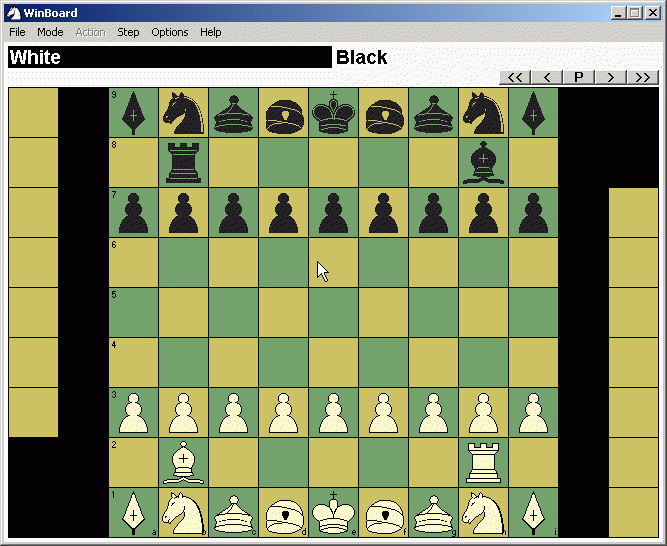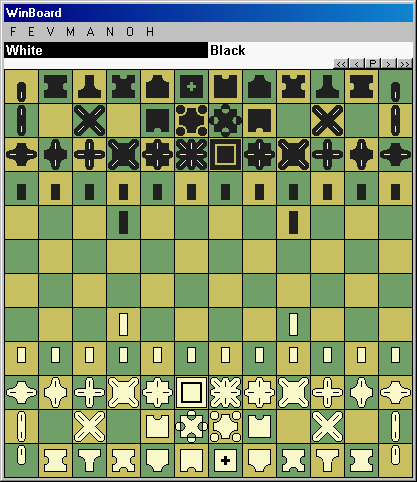Important physical design elements shouldn't rely on subtle and contrived lighting conditions. Just sayin'...
SHOGI (Try it)

After a lot of repetition, I too have come to internalize the kanji characters and which pieces they represent. However, it still stands that alphabetic characters, regardless of typeface, are less mnemonically useful than object icons. When you see many game pieces in close proximity and at a distance it all looks like a mass of indistinguishable line strokes, which I (and anyone who understands graphic design, especially for games) consider poor physical design.
Case in point, if you watch Hidetchi's first video lesson on how to play Shogi, he dumps the traditional 2-kanji piece set he owns onto the board in a pile and then searches for particular pieces. It is clear that even though he knows the kanji intimately, both because he is a Japanese adult and because he has a 5-dan amateur ranking and knows Shogi very well, even he has difficulty sifting through the pieces finding the ones he wants. No matter how you spin it, the kanji symbols are not very clear or easy to visually parse, even if you know what they stand for.
Imagine a chess game diagram in which the pieces are not color coded and in which ornate, medieval-style gothic letters are used to represent the pieces. Nobody in their right mind would consider that ideal, or preferred, over the Staunton icons we use today. They are not cartoonish unless you have some sort of irrational bias against icons in general. A picture of a horse's head is culture-neutral, easy to visually parse, and conveys the notion of "knight" far better than a bunch of arbitrary letterform strokes. I regard this as so self-evident that it amazes me it needs to be explained at all, much less argued for rhetorically.
WOW, you're getting a bit defensive here. First of all, what makes something cartoonish is not it's symbolic meaning, but the form it is represented. An icon may be cartoonish or not and yet represent exactly the same thing.
Read my post and you'll see that I NEVER defended that kanjis are better representation for game pieces than the figurative shapes of chess. On the contrary, I state that, at a first glimpse, stauton pieces are really easier to distinguish.
You're reasoning is, nevertheless, lacking a bit, since it is directioned at unvalidating the kanjis as the main variable which makes pieces less distinguishable. In fact, there is a lot more information on chess pieces to take them from a pile than just the choice of their shapes. Apart from color, they have a much wider set of three-dimensional information, which helps a lot when pieces aren't laid properly on the board, after all, you can distinguish a rook from any angle, which isn't true for a shogi piece. Put color and difference in size, and you have a great deal of variables in play.
Yet, as I said, it isn't stated anywhere in my post that the figurative and more simple shapes of a stauton set, even in 2d, aren't more easy to distinguish. It amazes me that you were able to see otherwise, even if my english is far from perfect.

In the WinBoard GUI you can play Shogi with Chess-like piece icons:

I have also been experimenting with a 'mnemonic piece set', which sort of suggests how the pieces move:

This was not so much for regular Shogi, but for the larger Shogi variants like Chu (where you have 28 different piece types, so that even conventional pictograms become too difficult to learn / remember:


Great job. Shôgi is an incredibly fun and rich game and it's a pity people don't play it because of a misunderstanding: for some mysterious reasons they think we should read kanjis to recognize the different pieces.
To think in that way is wrong in fact: we should consider them like drawings/symbols and recognizing the different drawings/symbols becomes as easy as recognizing 2D Fritz chess pieces. Things become infinitely easier in that way.
As a chess player myself, I learned to recognize the Shôgi pieces without difficulty -of course I certainly needed two or three "crash-test" games to handle them, you cannot expect to have everything for free, just like in chess.
Yes, there is less activity in occidental Shôgi than in chess, but the first big Shôgi spreading outside Japan is very recent (2nd part of 20th century). And how did we do when FIDE chess was only a game between lots of chesslike games? --> we just created all activity, clubs, federations, tournaments,... by ourselves and it took hundreds of years 

This is great! Not many people I know care too much for the game, but it's nice to see some publicity, it really helps visualization skills I would say too because of the drops.

This discussion on piece form is a little on the nose. If you ask people on a chess site what they think of shogi pieces of course, the =general= consensus is that chess iconology is better, that's your audience. I'm sure the discussion on shogi forums (wherever they might be) would probably have them complaining about the "overly simplistic" icons or pieces we use in chess.
Each game is entitled to its own history and iconology; its not for a bunch of unititiated chess players to tell shogi masters that their pieces suck (just as the reverse is true). I think its a case of take it or leave it. In any event, chess pieces were not always so immediately distinguishable it should be recalled (thats why the staunton set was put out - french regence set, anyone?)
Thanks for the opening post though, I'd never really seen anything of shogi before and I found it very interesting.



Ah the old "I've studied this, so I know better" card eh :p
Tell me my friend, have you studied sociology or cultural anthropology? Are you an expert in those too? Because that will tell you that the generalisations you are making are pretty confined to your very limited graphic-design/chess-is-what-I-know-paradigm.
Link to the youtube vid, so we can all judge for ourselves?

Good post. Shogi is a great game. i just wish there were places to play over the board here. I find it much more complicated than Western chess.
Zslane: I see the point you're making and I agree. Of course once you learn it it's easier to tell the pieces apart, but yes it would be that much less intuitive to play western chess with flat pieces with letters on them. I'll go so far as to say that it's harder to pick up these flat pieces too. Yes you can learn to play with them and do so with minimal interference, but to say that this is not an issue isn't intellectually honest.


Where can I find a shogi website like chess.com but for shogi ? With "online shogi" and "live shogi" ? If someone knows ... Thanks

There is no equivalent to chess.com for Shogi that I'm aware of. Not in English anyway. Maybe in Japanese. The next best thing is these two websites:
http://forum.81squareuniverse.com/
Yes, Shogi is the Japanese equivalent to chess.

I think shogi got a few things right that western chess has wrong. in shogi you lose if you do a perpetual check, in western chess this allows you to draw which is really lame and makes certain positions just highly annoying and not fun. in shogi there are more variety of pieces with different movements, each piece promotes into a unique piece (dragon horses, dragon kings etc much cooler) and there's drops like in bughouse.
the only thing shogi has wrong is the "pieces" themselves. they should be figurines like in western chess, writing the name on a little piece of wood is lame. they should have figurines for the gold general, silver general, dragon horse and dragon king. could use the same figurines for pawns, lances, rooks and kings that you have in western chess. (and there's no absurdly romantic/awkward all powerful queen piece which I do think holds western chess back ---its fun and all but it has certain limitations. perhaps it might be ok to have a piece like this if they got rid of draw through perpetual check and adopted the shogi rule for this)
someone already had this idea and I think they are on the right track
http://www.eurasia-chess.com/links_en.php
shogi and western chess need to be combined in some way. most imporatntly western chess needs to incorporate or adopt the shogi rules for perpetual check, promotions, repetitions, impasse and drops.
I think japan got chess right (which makes sense---homeland of martial arts, chess is most like a martial art), the only thing they got wrong was the pieces. they need to be figurines like in western chess, not the names written on little pieces of wood.






Second is the fact that captured pieces are added to one's own forces, making color distinctions between armies impractical. You would have to double the number of pieces in a set just to employ color distinction between armies. The fact that the same pieces can be used by either side is ideal, even though the rather subtle use of piece shape and orientation is less than ideal.
Two colors is still no problem.
The pieces are NOT flat, so when the light comes in a low angle, the pieces of one player looks darker than from the other.
The following photo (!!!) of a chu shogi game describes what I'm speaking about in a perfect way (but in normal games it wouldn't be such strong visible):